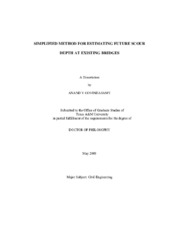| dc.description.abstract | Bridge scour is the term which describes the erosion of soil surrounding a bridge
foundation due to water. Bridge scour can cause the reduction of the load carrying
capacity of bridge foundations, excessive foundation settlements, and damage to bridge
abutments. Bridges with foundations that are unstable for calculated and/or observed
scour conditions are termed scour critical bridges.
Approximately 25,000 bridges in the United States are classified as scour critical
and about 600 of them are in Texas. This designation comes in part from the use of
over-conservative methods that predict excessive scour depths in erosion resistant
materials. Other methods have been developed to eliminate this over-conservatism but
are uneconomical because they require site-specific erosion testing.
The major contribution of this dissertation is a new method to assess a bridge for
scour and erosion classification charts which categorizes the erodibility of geomaterials
according to conventional engineering properties. The new method is a three level
Bridge Scour Assessment (BSA) procedure which is relatively simple and economical. It
does not require site-specific erosion testing and eliminates the over-conservatism in current methods. The first level, BSA 1, uses charts that extrapolate the maximum scour
depth recorded during the life of the bridge to obtain the scour depth corresponding to a
specified future flood event. The second level, BSA 2, determines the maximum scour
depth and is carried out if BSA 1 does not conclude with a specific plan of action for the
bridge. The third level, BSA 3, determines the time dependent scour depth and is carried
out if BSA 2 does not conclude with a specific plan of action. The scour vulnerability
depends on the comparison between the predicted and allowable scour depths.
The 11 case histories used to validate the new method showed good agreement
between predicted values and field measurements. BSA 1 was then applied to 16
bridges. In this process, 6 out of 10 bridges classified as scour critical by current
methods were found to be stable. These results show that the new method allows for
more realistic evaluation of bridges for scour while not requiring site-specific erosion
testing. | en |


